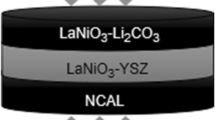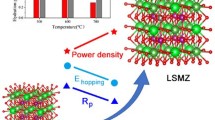Abstract
The reduction of the operating temperatures of solid oxide fuel cells (SOFCs) has attracted global research attention and inspired considerable efforts toward the development of new materials for low-temperature (LT) operation, such as K2NiF4-type electrode La2NiO4 (LNO). In this study, to explore the ion-conducting capability of LNO as an SOFC electrolyte while simultaneously maintaining good catalytic activity, a p–n heterostructure composite was constructed by incorporating p-type LNO with n-type ZnO. The as-prepared LNO–ZnO exhibited a bulk heterostructure with a favorable biphasic distribution and a number of heterointerface contacts. When the as-prepared LNO–ZnO was applied as the electrolyte layer in the SOFC, it exhibited a maximum fuel cell power density of 707 mW cm−2 with an open-circuit voltage of 1.04 V at 550 °C, as well as considerable stability. According to further measurements, the energy band structures of the two semiconductors and the rectifying characteristics of the LNO–ZnO heterostructure were investigated. The results revealed that the electrolyte functionality of LNO–ZnO is realized predominantly by the built-in electric field of the p–n heterojunction to transport ions while simultaneously blocking electrons. Our results thus demonstrated that K2NiF4-type LNO can serve not only as an electrode but also as an electrolyte and suggested that the built-in electric field-assisted heterostructure is a feasible approach for developing LT-SOFC materials.









Similar content being viewed by others
Data availability
The datasets generated during and/or analyzed during the current study are available from the corresponding author on reasonable request.
References
S. Shaikh, A. Muchtar, M. Somalu, A review on the selection of anode materials for solid oxide fuel cells. Renew. Sustain. Energy Rev. 51, 1–8 (2015)
K. Schlichting, N. Padture, P. Klemens, Thermal conductivity of dense and porous yttria-stabilized Zirconia. J. Mater. Sci. 36, 3003–3010 (2001)
Y. Zhang, R. Knibbe, J. Sunarso, Y. Zhong, W. Zhou, Z. Shao et al., Recent progress on advanced materials for solid oxide fuel cells operating below 500°C. Adv. Mater 29, 1700132–1700164 (2017)
T. Tsai, S. Barnett, Effect of mixed-conducting interfacial layers on solid oxide fuel cell anode performance. J. Electrochem. Soc. 145, 1696–1701 (1998)
K. Eguchi, Current status and issues for development of solid oxide fuel cells. Electrochemistry. 77, 114–114 (2009)
L. Fan, C. Wang, O. Osamudiamen, R. Raza, M. Singh, B. Zhu, Mixed ion and electron conductive composites for single component fuel cells: I. Effects of composition and pellet thickness. J. Power Sour. 217, 164–169 (2012)
B. Zhu, B. Wang, Y. Wang, R. Raza, W. Tan, J. Kim et al., Charge separation and transport in La0.6Sr0.4Co0.2Fe0.8O3-δ and ion-doping ceria hetero-structure material for new generation fuel cell. Nano Energy. 37, 195–202 (2017)
B. Zhu, Y. Huang, L. Fan, Y. Ma, B. Wang, C. Xia et al., Novel fuel cell with nanocomposite functional layer designed by perovskite solar cell principle. Nano Energy. 19, 156–164 (2016)
B. Zhu, Fuel cells: three in one. Nat. Nanotechnol. 6, 330 (2011)
Y. Xing, Y. Wu, L. Li, Q. Shi, J. Shi, S. Yun, B. Zhu, Proton shuttles in CeO2/ CeO2-δ core-shell structure. ACS Energy Lett. 4, 2601–2607 (2019)
N. Mushtaq, C. Xia, W. Dong, B. Wang, R. Raza, A. Ali et al., Tuning the energy band structure at Interfaces of the SrFe0.75Ti0.25O3–δ–Sm0.25Ce0.75O2–δ heterostructure for fast ionic transport. ACS Appl. Mater. Interfaces 11, 38737–38745 (2019)
Z. Qiao, C. Xia, Y. Cai, M. Afzal, H. Wang, J. Qiao, B. Zhu, Electrochemical and electrical properties of doped CeO2-ZnO composite for low-temperature solid oxide fuel cell applications. J. Power Sour. 392, 33–40 (2018)
Y. Wu, B. Dong, J. Zhang, H. Song, C. Yan, The synthesis of ZnO/SrTiO3 composite for high-efficiency photocatalytic hydrogen and electricity conversion. Int. J. Hydrog. Energy. 43, 12627–12636 (2018)
C. Xia, Y. Mi, B. Wang, B. Lin, G. Chen, B. Zhu, Shaping triple-conducting semiconductor BaCo0.4Fe0.4Zr0.1Y0.1O3-δ into an electrolyte for low-temperature solid oxide fuel cells. Nat. Commun. 10, 1707 (2019)
Q. Shi, H. Zhong, M. Huang, B. Zhu, L. Huang, Y. Wu, Fast ionic transport in SrTiO3/LaAlO3 heterostructure. Chem. Commun. 58, 13919–13922 (2022)
T. Klande, K. Efimov, S. Cusenza, K. Becker, A. Feldhoff, Effect of doping, microstructure, and CO2 on La2NiO4-δ-based oxygen transporting materials. J. Solid State Chem 184, 3310–3318 (2011)
K. Maas, C. Wulles, J. Roque, B. Ballesterros, V. Lafarge, J. Santiso, M. Burriel, Role of pO(2) and film microstructure on the memristive properties of La2NiO4+δ/LaNiO3-δ bilayers. J. Mater. Chem. A 10, 6523–6530 (2022)
M. Al Daroukh, V. Vashook, H. Ullmann, F. Tietz, I.A. Raj, Oxides of the AMO3 and A2MO4-type: structural stability, electrical conductivity and thermal expansion. Solid State Ion. 158, 141–150 (2003)
S. Skinner, J. Kilner, Oxygen diffusion and surface exchange in La2-xSrxNiO4-δ. Solid State Ion. 135, 709–712 (2000)
M. Escudero, A. Fuerte, L. Daza, La2NiO4+δ potential cathode material on La0.9Sr0.1Ga0.8Mg0.2O2.85 electrolyte for intermediate temperature solid oxide fuel cell. J. Power Sour. 196, 7245–7250 (2011)
N. Solak, M. Zinkevich, Aldinger. Compatibility of La2NiO4 cathodes with LaGaO3 electrolytes: a computational approach. Solid State Ion. 177, 2139–2142 (2006)
G. Yang, C. Su, R. Ran, M. Tade, Z. Shao, Advanced symmetric solid oxide fuel cell with an infiltrated K2NiF4-Type La2NiO4 electrode. Energy & Fuels. 28, 356–362 (2014)
D. Perez-Coll, A. Aguadero, Electrochemical performance of La2NiO4-based cathode for solid oxide fuel cells Single cell test. Fuel Cells 11, 91–101 (2011)
G. Amow, S.J. Skinner, Recent developments in Ruddlesden–Popper nickelate systems for solid oxide fuel cell cathodes. J. Solid State Electrochem. 10(8), 538–546 (2006)
S. Suwanboona, P. Amornpitoksukb, A. Haidouxc, Structural and optical properties of undoped and aluminium doped zinc oxide nanoparticles via precipitation method at low temperature. J. Alloys Compd. 462, 335–339 (2008)
J. Zhou, G. Chen, K. Wu, Y. Cheng, Interaction of La2NiO4 (100) surface with oxygen molecule: a first-principles study. J. Phys. Chem. C 117, 12991–12999 (2013)
J. Sun, X. Qiu, F. Wu, W. Zhu, H2 from steam reforming of ethanol at low temperature over Ni/ Y2O3, Ni/La2O3 and Ni/Al2O3 catalysts for fuel-cell application. Int. J. Hydrogen Energy. 30, 437–445 (2005)
B. Tu, Y. Dong, B. Liu, M. Cheng, Highly active lanthanum doped nickel anode for solid oxide fuel cells directly fuelled with methane. J. Power Sour. 165, 120–124 (2014)
H. Hu, Q. Lin, Z. Zhu, B. Zhu, X. Liu, Fabrication of electrolyte-free fuel cell with Mg0.4Zn0.6O/Ce0.8Sm0.2O2-δ-Li0.3Ni0.6Cu0.07Sr0.03O2-δ layer. J. Power Sour. 248, 577–581 (2014)
Y. Wu, L. Liu, X. Yu, J. Zhang, L. Li, C. Yan, B. Zhu, Natural hematite ore composited with ZnO nanoneedles for energy applications. Compos. Part B 137, 178–183 (2018)
B. Zhu, R. Raza, H. Qin, L. Fan, Single-component and three-component fuel cells. J. Power Sour. 196, 6362–6365 (2011)
C. Xia, B. Wang, Y. Cai, W. Zhang, M. Afzal, B. Zhu, Electrochemical properties of LaCePr-Oxide/K2WO4 composite electrolyte for low-temperature SOFCs. Electrochem. Commun 77, 44–48 (2017)
H. Lahmar, M. Benamira, S. Douafer, L. Messaadia, A. Boudjerda, M. Trari, Photocatalytic degradation of methyl orange on the novel hetero-system La2NiO4/ZnO under solar light. Chem. Phys. Lett. 742, 137132 (2020)
S. Nho, G. Baek, S. Park, B. Lee, M. Cha, D. Lim et al., Highly efficient inverted bulk-heterojunction solar cells with a gradiently-doped ZnO layer. Energy Environ. Sci 9, 240–246 (2016)
S. Chatterjee, A. Bera, Pal. p-i-n heterojunctions with BiFeO3 perovskite nanoparticles and p- and n-Type oxides: photovoltaic properties. ACS Appl. Mater. Interfaces 6, 20479–20486 (2014)
D. Aidhy, B. Liu, Y. Zhang, W. Weber, Strain-induced phase and oxygen-vacancy stability in ionic interfaces from first principles calculations. J. Phys. Chem. C 118, 30139–30144 (2014)
W. Luo, F. Li, Q. Li, X. Wang, W. Yang, L. Zhou, L. Mai et al., Heterostructured Bi2S3-Bi2O3 nanosheets with a built-in electric field for improved sodium storage. ACS Appl. Mater. Interfaces 10, 7201–7207 (2018)
Y. Xia, X. Liu, Y. Bai, H. Li, X. Deng, X. Niu et al., Electrical conductivity optimization in electrolyte-free fuel cells by single-component Ce0.8Sm0.2O2δLi0.15Ni0.45Zn0.4 layer. RSC Adv 2, 3828–3834 (2012)
Acknowledgements
This work was supported by the Scientific and Technological Innovation Team of Nanjing (Grant No. NINGJIAOGAOSHI2021No.16).
Funding
This study was supported by the Scientific and Technological Innovation Team of Nanjing (NINGJIAOGAOSHI2021No.16).
Author information
Authors and Affiliations
Contributions
All authors contributed to the study conception and design. Material preparation, data collection, and analysis were performed by [YL], [CX], [SY], and [CL]. The first draft of the manuscript was written by [YL] and all authors commented on previous versions of the manuscript. All authors read and approved the final manuscript.
Corresponding authors
Ethics declarations
Competing interests
The authors have no relevant financial or non-financial interests to disclose.
Additional information
Publisher’s Note
Springer Nature remains neutral with regard to jurisdictional claims in published maps and institutional affiliations.
Rights and permissions
Springer Nature or its licensor (e.g. a society or other partner) holds exclusive rights to this article under a publishing agreement with the author(s) or other rightsholder(s); author self-archiving of the accepted manuscript version of this article is solely governed by the terms of such publishing agreement and applicable law.
About this article
Cite this article
Lu, Y., Yousaf, M., Xia, C. et al. Built-in electric field-assisted heterostructure electrolyte based on K2NiF4-type La2NiO4 for solid oxide fuel cells. J Mater Sci: Mater Electron 34, 1440 (2023). https://doi.org/10.1007/s10854-023-10812-0
Received:
Accepted:
Published:
DOI: https://doi.org/10.1007/s10854-023-10812-0




